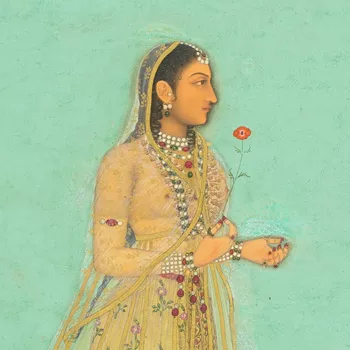रागिनी तोड़ी Ragini Todi (The musical mode Todi) c. 1800
Opaque watercolour including metallic pigments on paper. | 20.9 x 15.8 cm (whole object) | RCIN 1005127
-
A pictorial depiction of the Hindustani musical mode Todi.
In Hindustani classical music, there are no set compositions but modes or frameworks, called ragas, on which musicians build each performance. These ragas are associated with particular scales and distinct melodic structures, to be performed in different seasons and at different times of day. Traditionally there are six ‘male’ ragas each of which have five ‘female’ raginis, giving a typical ragamala (garland of ragas) 36 individual melodies. Each elicits a different rasa (‘essence’ or ‘mood’). This rasa is also expressed in the poetic lyrics which accompany the music and was captured by painters in ragamala paintings.
Todi is a late morning melody associated with summer intended to evoke a pensive mood. Todi is commonly represented as a beautiful heroine separated from her lover who thinks of him as she wanders the forest. She plays a stringed instrument and her enchanting music causes the animals to awaken. A black buck - a poetic symbol of the absent lover - gazes up at the heroine in wonder, she looks down, and their eyes meet
The style of the painting and its borders associate it with the artists of the Punjab Hills in the early 19th century.Provenance
This painting is one of a group twelve (RCINS 925221-32) found in an Indian silk brocade folder acquired by Edward VII when Prince of Wales, likely during his Tour of India in 1875-6.
-
Creator(s)
Acquirer(s)
-
Medium and techniques
Opaque watercolour including metallic pigments on paper.
Measurements
20.9 x 15.8 cm (whole object)
14.6 x 9.9 cm (image)










